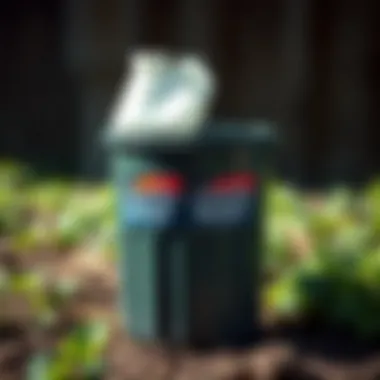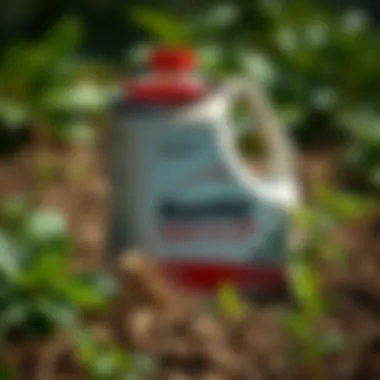Effective Disposal of Roundup Weed Killer


Overview of the Topic
Roundup weed killer is a common herbicide that millions of farmers and gardeners employ to manage pesky weeds. However, its primary ingredient, glyphosate, poses complex challenges when it comes to disposal. Understanding how to effectively and safely dispose of Roundup is not just a matter of convenience; it has far-reaching implications for our environment and, ultimately, for our health.
Definition and Importance
Roundup is a brand name for a herbicide that primarily contains glyphosate. This chemical works by inhibiting specific enzymes essential for plant growth, making it highly effective against a broad spectrum of weeds. While it has been a mainstay in agriculture, its active component comes with risk factors that call for careful management, particularly when it’s time to dispose of any unused or leftover product. Proper disposal is essential to minimize the impact on soils, waterways, and surrounding ecosystems.
Current Trends
In recent years, the issue of glyphosate safety has taken center stage in both scientific and public discourse. As more studies and conversations emerge about its potential health effects, many agricultural professionals are increasingly prioritizing safe disposal methods. New regulations and community guidelines are also shaping how products like Roundup should be handled at the end of their lifecycle, making it crucial for users to stay informed.
Key Techniques and Practices
When considering how to get rid of leftover Roundup properly, several best practices come into play.
Step-by-Step Guide
Here is a simple outline you can follow when discarding Roundup:
- Assess the Material: Evaluate what is left – is it full, half-full, or almost empty? This can guide your disposal method.
- Check Regulations: Always consult local laws regarding hazardous waste disposal. Different states or countries have varying rules about glyphosate disposal.
- Rinse Containers: If you have empty containers and they’re made of plastic, rinse them thoroughly with water. Ensure that no residue remains before recycling.
- Utilize Collection Sites: Arrange for appropriate disposal at designated hazardous waste collection centers. Many regions offer specific days for chemicals.
- Document Your Actions: Keep a record of your disposal process—this can be useful for both accountability and regulatory purposes.
Tools and Equipment Needed
- Protective Gear: Gloves and masks are essential for handling any chemicals safely.
- Rinsing Equipment: A standard hose or bucket works for rinsing containers.
- Storage Containers: If you're transporting waste, use leak-proof containers to prevent spills.
Challenges and Solutions
While the methods for disposing of Roundup may seem straightforward, several challenges can complicate the process.
Common Obstacles
- Lack of Knowledge: Many users are unaware of local regulations relating to herbicide disposal.
- Environmental Concerns: The potential repercussions of improper disposal on local ecosystems can create anxiety among users.
Innovative Solutions
To combat these issues, regular training workshops can be effective. Bringing awareness to laws and providing hands-on experience with safe disposal methods can empower agricultural workers. Reaching out to local agriculture extension offices can also provide resources and guidance tailored to specific regions.
"Proper disposal mitigates risks to human health and the environment. It's a responsibility we all share."
Understanding Roundup Weed Killer
The topic of Roundup weed killer is essential for anyone involved in agriculture and land management. Its widespread use makes understanding this herbicide critical, not only for effective application but also for safe and responsible disposal. Through this article, we aim to shed light on various aspects of Roundup, providing insights that go beyond the surface. Knowing what Roundup is, its chemical makeup, and its mechanisms of action can help agricultural professionals navigate its use safely and effectively.
What is Roundup?
Roundup is a brand name for a herbicide that primarily contains glyphosate, a broad-spectrum systemic herbicide. Farmers and gardeners often reach for Roundup due to its effectiveness in killing unwanted weeds and grasses. The significance of Roundup lies not only in its efficiency but also in the debates surrounding its use, particularly concerning health and environmental safety. Understanding what it is offers a foundational perspective for discussing best practices in handling it.
Chemical Composition
Roundup's active ingredient, glyphosate, is known for its ability to inhibit a specific enzyme pathway crucial for plant growth. Beyond glyphosate, Roundup also includes various inert ingredients, which can impact the effectiveness and behavior in the environment. Each component plays a role in how Roundup interacts with weeds, soil, and non-target organisms. Recognizing the full chemical composition helps users comprehend both the herbicide's efficacy and its potential environmental implications.
How Roundup Works


To grasp how Roundup operates, one must delve into its mode of action. Glyphosate works by disrupting the shikimic acid pathway, an essential metabolic route found in plants but absent in animals. Consequently, when Roundup is applied to plants, it essentially starves them, leading to their demise. This specificity is part of why many users opt for Roundup over other herbicides. However, this very mechanism raises questions about its effects on non-target species, making its use a topic of considerable debate within environmental circles.
Understanding how Roundup works not only aids in effective weed management but also highlights the need for safe practices during its use and disposal.
In writing about Roundup, we acknowledge both its productive use in agriculture and the cautious tendencies needed when handling chemicals. This understanding forms the groundwork for the subsequent exploration of health concerns, regulatory considerations, and responsible disposal methods.
Health and Environmental Concerns
When discussing the disposal of Roundup weed killer, it’s crucial to consider the health and environmental concerns surrounding its use. As glyphosate-containing products are prevalent in agricultural practices, understanding their implications becomes paramount. This section sheds light on the serious risks associated with glyphosate, the broad impacts on ecosystems, and the potential for water contamination. Each point serves to educate both farmers and individuals using this product, emphasizing the necessity for responsible use and disposal to safeguard health and ecological integrity.
Toxicity of Glyphosate
Glyphosate is the active ingredient in Roundup that makes it effective as a herbicide. While it efficiently targets unwanted plant growth, its toxicity has raised concerns. Studies have suggested that glyphosate may pose risks to both human health and animal life.
- Human Health Risks: Research has linked glyphosate to various health issues, including potential carcinogenic effects. The International Agency for Research on Cancer classified it as probably carcinogenic to humans based on limited evidence of carcinogenicity in humans and sufficient evidence in animals for the carcinogenicity of glyphosate. Thus, individuals using Roundup should take precautions to minimize exposure.
- Toxic Effects on Wildlife: Glyphosate doesn’t discriminate; it can affect non-target organisms as well. For instance, studies suggest that certain amphibians and fish can experience adverse effects when exposed to glyphosate through agricultural runoff. Protecting biodiversity is vital, as ecosystems depend heavily on the interplay among various species.
Impacts on Non-target Organisms
The disruption of ecosystems is another concern linked to glyphosate use. When Roundup is applied, it targets more than the intended weed species. The herbicide can adversely affect beneficial insects, soil organisms, and other wildlife in various habitats.
- Beneficial Insects: Pollinators like bees are crucial for crop production. Some research indicates that glyphosate may impair bees’ abilities to forage efficiently, putting them at risk due to decreased food sources.
- Soil Health: Various organisms in the soil help maintain its fertility. Glyphosate can alter the microbial communities that decompose organic matter, potentially leading to reduced soil health. Farmers should realize that maintaining healthy soil is critical for sustainable agriculture.
Water Contamination Risks
Water safety is a hot-button issue when discussing herbicides, including Roundup. When glyphosate is applied on crops, it may run off into nearby water systems, leading to contamination.
- Runoff Contamination: Rainfall can wash glyphosate from the land into rivers and lakes, affecting aquatic ecosystems. As a result, there is a risk of harming fish populations or other aquatic life.
- Drinking Water Concerns: Contaminated waterways raise significant concerns over drinking water safety. Certain studies have found glyphosate residues in groundwater, which may pose risks to human health over time.
"The effects of glyphosate are far-reaching, intertwining with human and environmental health — it is a wake-up call to prioritize safe disposal and responsible use."
Addressing these health and environmental concerns is essential not only for the immediate safety of individuals but also for the long-term sustainability of our ecosystems. By grasping the full scope of glyphosate's implications, we can make educated decisions about herbicide usage and disposal.
Understanding Disposal Regulations
Navigating the complexities of herbicide disposal is crucial for anyone involved in agriculture. Understanding disposal regulations helps ensure not only compliance with the law but also safeguards public health and environmental integrity. When it comes to Roundup weed killer, the implications of haphazard disposal can be far-reaching, impacting both our ecosystems and communities. Following guidelines provides several benefits, including minimizing risks to human health, preserving water quality, and fostering responsible agricultural practices.
Federal Guidelines for Herbicide Disposal
Federal guidelines lay a solid foundation for the safe disposal of herbicides, including Roundup. The Environmental Protection Agency (EPA) is the leading authority that dictates how such chemicals should be handled. According to EPA regulations:
- Disposal of empty containers: Containers should be triple rinsed and then punctured to prevent reuse. They must be disposed of in accordance with local waste management laws.
- Unused product management: It's recommended that any unused herbicide be taken to a hazardous waste disposal facility rather than being poured down the drain or discarded in general waste.
Adherence to these guidelines is not just necessary to avoid penalties; it is a way of demonstrating a commitment to environmental stewardship. As the saying goes, "a stitch in time saves nine"—a little compliance now can prevent larger issues later on.
State Regulations and Variations
Beyond federal regulations, state laws often add further requirements for herbicide disposal. This means that farmers must not only stay abreast of national standards but also be aware of local rules that can vary significantly.
- Some states might require specific labeling for disposal, while others may have dedicated collection days for hazardous wastes, which differ from federal guidelines.
- It's crucial to consult your state's agricultural extension services or environmental agency to ensure compliance with local regulations.
Key Considerations
- Know your state's specific regulations to avoid any legal repercussions.
- Some states may impose stricter guidelines due to higher environmental sensitivity.


Labeling Requirements
Labeling isn’t merely a formality; it encompasses vital information regarding the herbicide's proper handling and disposal. Manufacturers of Roundup must include specific instructions on the label, detailing:
- How to dispose of any remaining product and that empty containers must be handled responsibly.
- Safety measures for accidental spills or exposure during disposal.
In most instances, regulations stipulate that the label must remain intact and easily readable until the container is completely disposed of. Remember: ignoring the labeling can lead to improper disposal, leading not only to environmental hazards but also to potential penalties.
"Proper disposal isn’t merely a guideline; it’s a responsibility to future generations and our shared resources."
By understanding these regulations, agricultural professionals can engage in practices that not only protect their livelihoods but also ensure a healthier ecosystem. Complying with both federal and state regulations, along with heeding labeling instructions, form the trifecta that supports efficient and responsible herbicide disposal.
Best Practices for Disposal
The disposal of Roundup weed killer is not just a matter of convenience but a crucial component of responsible agricultural practice. Mismanagement or negligence can lead to severe health and environmental hazards. Farmers and agricultural enthusiasts must adhere to established protocols when dealing with herbicide disposal to mitigate risks associated with mistaken usage or improper waste management. This section will outline best practices designed to ensure safe, compliant disposal of Roundup weed killer.
Empty Container Disposal Methods
When it comes time to discard empty Roundup containers, it’s essential to follow proper methods to reduce their environmental footprint. Here are a few effective strategies:
- Triple Rinse: This method involves rinsing the container thrice with water, ensuring all residual herbicide is removed. Each rinse should be thoroughly poured out into the spray equipment used for the application, thus minimizing waste.
- Puncture and Crush: After rinsing, it is important to puncture both the lid and body of the container to prevent reuse. Crushing them can also reduce volume and facilitate easier disposal.
- Local Disposal Options: Check in with your community for specific disposal facilities equipped to handle agricultural waste. Many regions have designated centers that can recycle or safely dispose of herbicide containers.
Using proper disposal methods not only protects the environment but also helps maintain community health.
Handling Unused Product
Unused Roundup can present unique challenges. It is vital to handle any surplus product with care to avoid accidental release or environmental contamination. Here are some pointers:
- Store Safely: Keep any unused product securely stored in its original container, away from children and pets. Ensure it is in a cool, dry place, away from sunlight and extreme temperatures.
- Return to Retailer: If possible, return any unopened product to the retailer from which it was purchased. Many retailers have take-back programs specifically for agricultural chemicals.
- Disposal Guidelines: If returning isn’t an option, consult the label for specific disposal instructions. It often contains guidelines tailored to that particular herbicide.
Professional Disposal Services
In cases where DIY methods may not suffice or when dealing with large quantities of herbicide, engaging professional disposal services can be the most effective recourse.
- Certified Services: Look for disposal companies certified to handle hazardous materials. They possess the expertise and equipment necessary to manage herbicides safely.
- Cost Consideration: While hiring a professional service may incur a cost, it should be viewed as an investment in safety and compliance with environmental regulations.
- Documentation: Ensure that any service engaged provides documentation confirming the safe disposal of the herbicide. This record may be necessary for future regulatory inspections or audits.
Following these practices establishes a culture of responsibility amongst farmers and cultivators while promoting environmental safety and compliance with both state and federal regulations.
Environmental Considerations
When it comes to disposing of Roundup weed killer, understanding the environmental considerations is pivotal. The use of glyphosate-based herbicides presents potential risks to ecosystems, water supply, and biodiversity. This section elaborates on the essential elements that underscore the importance of careful disposal practices for these substances, focusing on assessing ecological impacts, adopting best practices for risk minimization, and fostering community awareness.
Assessing Ecological Impact
To begin, gauging the ecological impact of glyphosate involves studying how its residue may affect soil health and local wildlife. Glyphosate can persist in the soil and possibly alter microbial populations, which are key to maintaining soil structure and fertility. Furthermore, agroecosystems are intricately balanced, and even slight shifts in this balance can lead to unintended consequences.
The effects on non-target species also warrant serious attention. For instance, glyphosate might not only eliminate weeds but also have significant repercussions on insects and aquatic organisms. Monitoring these impacts through regular assessments can provide insights on contamination levels and their implications. Evaluating the entire food chain —from plants to herbivores and predators—can help in understanding the broader repercussions of its use.
Best Practices for Minimizing Risks
Implementing best practices for minimizing risks is crucial. Here are some strategies that can be employed:
- Follow Labels Carefully: Always abide by the instructions that come with the product label. This includes adhering to any stipulations on mixing, application methods, and especially disposal recommendations.
- Use Protective Gear: When handling glyphosate, using protective clothing is important to avoid personal exposure, which can indirectly affect the ecosystem if the person’s clothing comes into contact with soil or waterways.
- Educate Staff: Training agricultural workers on proper disposal methods can significantly mitigate risks associated with glyphosate.
- Store Securely: Containers should be stored in a cool, dry place away from environmental hazards. Proper storage can prevent accidental leaks that might contaminate the local environment.


Community Awareness and Involvement
Community awareness and involvement play a critical role in safeguarding the environment from the adverse effects of herbicides like Roundup. Engaging local stakeholders, including farmers, residents, and businesses, fosters a collective responsibility towards sustainable practices. Here are a few ways to promote this:
- Hold Workshops: Conduct community workshops that focus on safe herbicide use and disposal techniques. Sharing knowledge can create a ripple effect.
- Dialogue with Local Authorities: Advocating for clear regulations at the municipal level can prompt more effective enforcement of safe disposal practices.
- Participate in Cleanup Events: Organizing days to remove any herbicide-related waste can enhance community engagement while cleaning the local environment.
Community involvement is not just beneficial for the environment; it cultivates a sense of ownership and responsibility among all stakeholders. Together, we can work towards a greener future.
Illegal Disposal and Consequences
The issue of illegal disposal of Roundup weed killer isn't just a mere footnote in the broader conversation about herbicide safety; it's a vital topic that cuts right to the heart of agricultural and environmental stewardship. As farmers and agricultural professionals grapple with managing herbicides effectively, understanding the ramifications of careless disposal can save not only resources but also safeguard public health and the ecosystem. Proper disposal practices are not just guidelines—they’re a necessity to mitigate the risks associated with herbicides, especially glyphosate, contained in products like Roundup.
Risks of Improper Disposal
When it comes to the disposal of Roundup, the stakes are high. Improper disposal can lead to various problems:
- Contamination of Soil and Water: When Roundup is dumped on the ground or in a water source, it can seep into the soil and contaminate groundwater, which may eventually find its way into drinking supplies. Glyphosate's persistence means it can remain in the environment long after being improperly discarded.
- Public Health Hazards: Improper disposal may expose nearby residents and wildlife to harmful levels of glyphosate. This exposure can have short and long-term health effects, triggering concerns around potential carcinogenic properties.
- Legal Repercussions: Disposing of herbicides in non-compliant ways can result in hefty fines and legal troubles. Regulatory bodies, such as the Environmental Protection Agency (EPA) in the U.S., enforce strict rules about how to handle hazardous waste, and these regulations should always be top of mind.
"Understanding the legalities surrounding herbicide disposal is as crucial as knowing how to apply them responsibly. Don’t cut corners—your farm and community are at stake.”
Cases of Legal Infractions
There have been numerous instances where improper herbicide disposal led to significant consequences for individuals and communities alike:
- Local Landfills: In many cases, farmers have unknowingly mixed herbicides with regular waste, leading to contamination of local landfills. This can result in costly cleanups and fines levied against the responsible parties.
- Negligence: There have been reports of spills during transport, where individuals failed to report leaks or breaches in safety protocol, leading to legal actions from state and federal regulators.
- Community Complaints: Many communities have voiced their distress after discovering illegal disposal, which then results in governmental investigations and potential lawsuits against those responsible.
These cases serve as a stark reminder of what’s at stake when regulations are not followed.
Environmental Restoration Needs
Once illegal disposal has occurred, restoration becomes paramount. Addressing the fallout from these incidents requires time, resources, and concerted efforts:
- Remediation Techniques: Various techniques can be employed to restore contaminated sites. These methods include bio-remediation, where organisms are used to break down pollutants, or more traditional excavation and disposal of contaminated soil.
- Monitoring: Continuous monitoring of water and soil quality in affected areas is essential to determine the extent of damage and the efficacy of restoration efforts.
- Community Involvement: Engaging local communities in restoration projects not only aids in recovery but also fosters awareness about the proper disposal of agricultural chemicals.
Through collective effort, it is possible to heal the wounds left by negligent practices, but prevention is always better than cure. Keeping disposal method top of mind can spare farmers from the costs and headaches that illegal disposal can bring.
Future Directions in Herbicide Management
The discourse surrounding herbicide management is becoming increasingly relevant in today’s agricultural landscape. Farmers and agricultural enthusiasts alike are recognizing the need for innovation to balance effective weed control with environmental safety. The shift in perspective is product of growing public scrutiny and scientific advancements. The ensuing discussion ensues to explore rising technologies, evolving regulations, and pushes for sustainable practices as key elements of modern herbicide management.
Emerging Technologies in Weed Control
Innovation drives the future of weed control, opening doors to methods that appear to be less harmful while still effective. One profound area of development is the use of precision agriculture. By employing GPS and data analytics, farmers manage their chemical applications with surgical precision, applying herbicides only where they are truly needed. This not only minimizes waste but also reduces the chance of chemical runoff damaging surrounding ecosystems.
Furthermore, advancements in biological control methods provide an alternative to synthetic herbicides. Utilizing natural predators or competitive plants can effectively reduce weed burden. For instance, scientists are increasingly examining the use of cover crops that outsmart weeds by occupying the space, nutrients, and water that weeds need. These technologies signal a shift toward more integrated management strategies, reducing reliance on traditional herbicides.
Shifts in Regulatory Frameworks
As awareness of health and environmental impacts rises, the regulatory framework governing herbicide use is also changing. New policies emphasize stricter enforcement and monitoring of chemical applications. This shift aims at ensuring compliance with safety standards, while still allowing farmers to manage their crops effectively.
Legislative bodies are recognizing the need for adaptability in these frameworks. States may introduce more localized regulations based on unique environmental contexts. For example, California has instituted stringent measures requiring farmers to notify local authorities before applying specific herbicides. Keeping track of changes in these policies fosters an environment where farmers prioritize compliance, ultimately resulting in healthier ecosystems.
Encouraging Sustainable Practices
Sustainability isn’t just a buzzword; it’s a critical guiding principle for future herbicide management. Encouraging farmers to utilize integrated pest management (IPM) strategies supports a holistic approach. IPM combines biological control, cultural methods, and limited chemical use to create a sustainable farming environment.
Additionally, community engagement plays a crucial role in promoting these practices. Raising awareness about the importance of safe herbicide handling can stir more conscientious behaviors among farmers. Local workshops and educational programs can empower cultivators to foster an environment that prioritizes sustainability.
"The transition to sustainable practices in herbicide management is not just about protecting our lands but about preserving the future for generations to come."



